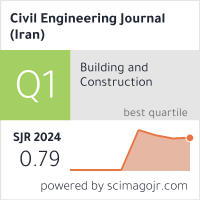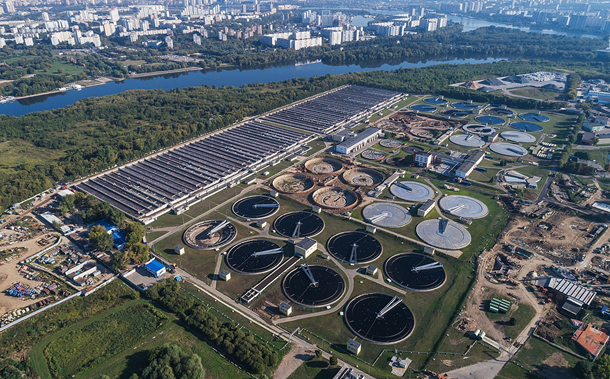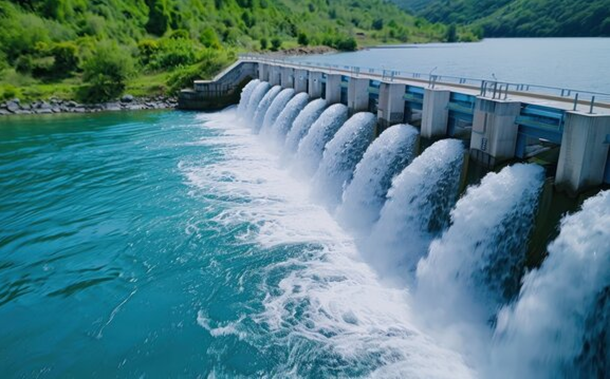Revolutionizing Recycled Aggregate Concrete: A Dual Approach Using HCl Treatment and Silica Fume
Downloads
Doi:10.28991/CEJ-2025-011-05-08
Full Text:PDF
Downloads
[2] Fediuk, R. S., Lesovik, V. S., Svintsov, A. P., Mochalov, A. V., Kulichkov, S. V., Stoyushko, N. Y., Gladkova, N. A., & Timokhin, R. A. (2018). Self-compacting concrete using pretreatmented rice husk ash. Magazine of Civil Engineering, 79(3), 66–76. doi:10.18720/MCE.79.7.
[3] Klyuev, S. V., Klyuev, A. V., Khezhev, T. A., & Pukharenko, Y. V. (2018). High-strength fine-grained fiber concrete with combined reinforcement by fiber. Journal of Engineering and Applied Sciences, 13(S8), 6407–6412. doi:10.3923/jeasci.2018.6407.6412.
[4] de Brito, J., Agrela, F., & Silva, R. V. (2019). Construction and demolition waste. New Trends in Eco-Efficient and Recycled Concrete, 1–22, Woodhead Publishing, Sawston, United Kingdom. doi:10.1016/b978-0-08-102480-5.00001-4.
[5] Sivamani, J., Neelakantan, T. R., Saravana Kumar, P., Mugesh Kanna, C., Vignesh Harish, H., & Akash, M. R. (2021). Efficient Utilization of Recycled Concrete Aggregates for Structural Applications”An Experimental Study. Proceedings of SECON 2020. SECON 2020. Lecture Notes in Civil Engineering, 97. Springer, Cham, Switzerland. doi:10.1007/978-3-030-55115-5_52.
[6] TC, D. R. (1994). Specifications for concrete with recycled aggregates. Materials and Structures, 27(9), 557–559. doi:10.1007/BF02473217.
[7] Karim, Y., Khan, Z., Alsoufi, M. S., & Yunus, M. (2016). A review on recycled aggregates for the construction industry. American Journal of Civil Engineering and Architecture, 4(1), 32-38.
[8] González-Taboada, I., González-Fonteboa, B., Martínez-Abella, F., & Carro-López, D. (2016). Study of recycled concrete aggregate quality and its relationship with recycled concrete compressive strength using database analysis. Materiales de Construccion, 66(323), e089. doi:10.3989/mc.2016.06415.
[9] Saravanakumar, P., & Dhinakaran, G. (2013). Strength Characteristics of High-Volume Fly Ash–Based Recycled Aggregate Concrete. Journal of Materials in Civil Engineering, 25(8), 1127–1133. doi:10.1061/(asce)mt.1943-5533.0000645.
[10] Tam, V. W. Y., Tam, C. M., & Le, K. N. (2007). Removal of cement mortar remains from recycled aggregate using pre-soaking approaches. Resources, Conservation and Recycling, 50(1), 82–101. doi:10.1016/j.resconrec.2006.05.012.
[11] Purushothaman, R., Amirthavalli, R. R., & Karan, L. (2015). Influence of Treatment Methods on the Strength and Performance Characteristics of Recycled Aggregate Concrete. Journal of Materials in Civil Engineering, 27(5), 04014168. doi:10.1061/(asce)mt.1943-5533.0001128.
[12] Ismail, S., & Ramli, M. (2013). Engineering properties of treated recycled concrete aggregate (RCA) for structural applications. Construction and Building Materials, 44, 464–476. doi:10.1016/j.conbuildmat.2013.03.014.
[13] Kaushik, S., & Bhan, P. S. (2024). Chemical Modifications of Recycled Concrete Aggregate. International Journal of Emerging Science and Engineering, 12(7), 7–12. doi:10.35940/ijese.g9900.12060724.
[14] Forero, J. A., de Brito, J., Evangelista, L., & Pereira, C. (2022). Improvement of the Quality of Recycled Concrete Aggregate Subjected to Chemical Treatments: A Review. Materials, 15(8), 2740. doi:10.3390/ma15082740.
[15] Allal, M., Zeghichi, L., & Larkat, K. (2024). Improvement of mechanical and interfacial properties (ITZ) of concrete based on treated recycled aggregates. Studies in Engineering and Exact Sciences, 5(1), 955–973. doi:10.54021/seesv5n1-050.
[16] Yan, X., Liu, T., & Zhang, B. (2024). Study on Strengthening Treatment of Recycled Aggregate and the Effect on the Mechanical Properties of Concrete. Advances in Transdisciplinary Engineering, 62, 421–426. doi:10.3233/ATDE241016.
[17] Saravanakumar, P., & Dhinakaran, G. (2015). Mechanical and durability properties of slag based recycled aggregate concrete. Iranian Journal of Science and Technology Transactions of Civil Engineering, 39(C2), 271-282.
[18] Zhao, H., & Zhou, A. (2024). Effects of recycled aggregates on mechanical and fractural properties of concrete: Insights from DEM modelling. Composites Part A: Applied Science and Manufacturing, 186(0). doi:10.1016/j.compositesa.2024.108395.
[19] Irfan, M. (2024). Importance of RE Utilization of Aggregate in Developing Concrete from Demolition Concrete Waste: Review. International Journal for Research in Applied Science and Engineering Technology, 12(2), 911–914. doi:10.22214/ijraset.2024.58474.
[20] Sharma, R., Jang, J. G., & Bansal, P. P. (2022). A comprehensive review on effects of mineral admixtures and fibers on engineering properties of ultra-high-performance concrete. Journal of Building Engineering, 45(0). doi:10.1016/j.jobe.2021.103314.
[21] Wang, X., Li, X., Zhong, Y., Li, H., & Wang, J. (2024). Properties and Microstructure of an Interfacial Transition Zone Enhanced by Silica Fume in Concrete Prepared with Coal Gangue as an Aggregate. ACS Omega, 9(1), 1870–1880. doi:10.1021/acsomega.3c08560.
[22] Rabab'ah, S. R., Al Hattamleh, O. H., Tarawneh, A. N., & Aldeeky, H. H. (2024). Experimental and ANN Analysis of Shearing Rate Effects on Coarse Sand Crushing. Civil Engineering Journal, 10(3), 824-834. doi:10.28991/CEJ-2024-010-03-011.
[23] Iqbal, M., Zhang, D., Khan, K., Amin, M. N., Ibrahim, M., & Salami, B. A. (2023). Evaluating mechanical, microstructural and durability performance of seawater sea sand concrete modified with silica fume. Journal of Building Engineering, 72. doi:10.1016/j.jobe.2023.106583.
[24] Alamri, M., Ali, T., Ahmed, H., Qureshi, M. Z., Elmagarhe, A., Adil Khan, M., Ajwad, A., & Sarmad Mahmood, M. (2024). Enhancing the engineering characteristics of sustainable recycled aggregate concrete using fly ash, metakaolin and silica fume. Heliyon, 10(7), 29014. doi:10.1016/j.heliyon.2024.e29014.
[25] Trykoz, L., Zinchenko, O., Borodin, D., Kamchatna, S., & Pustovoitova, O. (2024). Effect of treatment types of recycled concrete aggregates on the properties of concrete. Construction and Architecture, 23(3), 129–137. doi:10.35784/bud-arch.6318.
[26] Madhavarao, D. G., Sai, T. V. D., Ramya, T., Mahesh, T., Divya, M., & Babu, B. V. (2023). Evaluating The Performance of Acid-Treated (Hcl-Hno3) Recycled Aggregate in Environmentally Friendly Concrete. International Journal of Innovative Research in Engineering and Management, 10(2), 99–102. doi:10.55524/ijirem.2023.10.2.18.
[27] Kadarla, N., Siempu, R., & Murali Krishna, B. (2024). Studies on Performance of the Treated Recycled Concrete Coarse Aggregate in High-Strength Concrete. Journal of Physics: Conference Series, 2779(1). doi:10.1088/1742-6596/2779/1/012019.
[28] Joseph, H. S., Pachiappan, T., Avudaiappan, S., Maureira-Carsalade, N., Roco-Videla, í., Guindos, P., & Parra, P. F. (2023). A Comprehensive Review on Recycling of Construction Demolition Waste in Concrete. Sustainability (Switzerland), 15(6), 4932. doi:10.3390/su15064932.
[29] Balasubramani, G., & Palaniappan, M. (2025). Influence of acids and slurries on the properties of recycled concrete aggregates. Matéria (Rio de Janeiro), 30, e20240682. doi:10.1590/1517-7076-RMAT-2024-0682.
[30] Lv, D., Huang, K., & Wang, W. (2023). Influence of pretreatment methods on compressive performance improvement and failure mechanism analysis of recycled aggregate concrete. Materials, 16(10), 3807. doi:10.3390/ma16103807.
[31] Rama Rasagna, A. S. V. S., Siempu, R., & Murali Krishna, B. (2024). Studies on the Mechanical Properties of Recycled Aggregate Concrete using Treated Recycled Coarse Aggregates. Journal of Physics: Conference Series, 2779(1). doi:10.1088/1742-6596/2779/1/012046.
[32] Tam, V. W. Y., Soomro, M., & Evangelista, A. C. J. (2021). Quality improvement of recycled concrete aggregate by removal of residual mortar: A comprehensive review of approaches adopted. Construction and Building Materials, 288, 012046. doi:10.1016/j.conbuildmat.2021.123066.
[33] Ouyang, K., Liu, J., Liu, S., Song, B., Guo, H., Li, G., & Shi, C. (2023). Influence of pre-treatment methods for recycled concrete aggregate on the performance of recycled concrete: A review. Resources, Conservation and Recycling, 188. doi:10.1016/j.resconrec.2022.106717.
[34] Tang, A. J., De Jesus, R., & Cunanan, A. (2019). Microstructure and mechanical properties of concrete with treated recycled concrete aggregates. International Journal of GEOMATE, 16(57), 21–27. doi:10.21660/2019.57.4537.
[35] Panghal, H., & Kumar, A. (2024). Enhancing concrete durability and strength: An innovative approach integrating abrasion and cement slurry treatment for recycled coarse aggregates. Structural Concrete, 26(2), 1455–1476. doi:10.1002/suco.202400387.
[36] Panghal, H., & Kumar, A. (2024). Enhancing concrete performance: Surface modification of recycled coarse aggregates for sustainable construction. Construction and Building Materials, 411. doi:10.1016/j.conbuildmat.2023.134432.
[37] Feng, C., Wang, J., Cui, B., Ye, Z., Guo, H., Zhang, W., & Zhu, J. (2024). Evaluation of techniques for enhancing recycled concrete aggregates: Chemical treatment, biological modification and synergistic reinforcement. Construction and Building Materials, 420. doi:10.1016/j.conbuildmat.2024.135641.
[38] ASTM C109/C109M-11a. (2004). Standard Test Method for Compressive Strength of Hydraulic Cement Mortars (Using 2-in. or [50-mm] Cube Specimens). ASTM International, Pennsylvania, United States. doi:10.1520/C0109_C0109M-11A.
[39] ASTM C33/C33M-18. (2023). Standard Specification for Concrete Aggregates. ASTM International, Pennsylvania, United States. doi:10.1520/C0033_C0033M-18.
[40] Megaadd MS(D) Company. (2025). Densified micro silica construction chemical. Megaadd MS(D) Company, Sharjah, United Arab Emirates.
[41] ASTM C1240-20. (2003). Standard Specification for Silica Fume Used in Cementitious Mixtures. ASTM International, Pennsylvania, United States. doi:10.1520/C1240-20.
[42] BS 5328-2:1997. (1997). Concrete. Methods for specifying concrete mixes (AMD 9691) (AMD 10365) (AMD Corrigendum 10612) (AMD 13877). British Standards Institution (BSI), London, United Kingdom.
[43] Hansen, T. C., & Narud, H. (1983). Recycled concrete and silica fume make calcium silicate bricks. Cement and Concrete Research, 13(5), 626–630. doi:10.1016/0008-8846(83)90051-0.
[44] Li, J., Xiao, H., & Zhou, Y. (2009). Influence of coating recycled aggregate surface with pozzolanic powder on properties of recycled aggregate concrete. Construction and Building Materials, 23(3), 1287–1291. doi:10.1016/j.conbuildmat.2008.07.019.
[45] Mukharjee, B. B., & Barai, S. V. (2014). Influence of incorporation of nano-silica and recycled aggregates on compressive strength and microstructure of concrete. Computers and Chemical Engineering, 71(30), 570–578. doi:10.1016/j.conbuildmat.2014.08.040.
[46] Skoyles, E. R. (2000). Material control to avoid waste. Building Research Establishment Digest, London, United Kingdom, 3(259), 1-8,
[47] Alexander, M. G. (1994). Effects of aging on mechanical properties of the interfacial zone between cement paste and rock. Cement and Concrete Research, 24(7), 1277–1285. doi:10.1016/0008-8846(94)90112-0.
- Authors retain all copyrights. It is noticeable that authors will not be forced to sign any copyright transfer agreements.
- This work (including HTML and PDF Files) is licensed under a Creative Commons Attribution 4.0 International License.![]()















